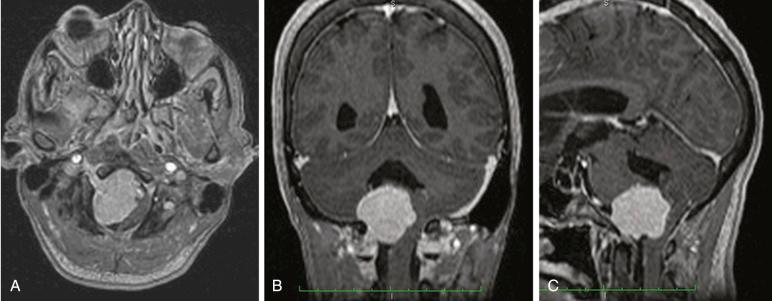Physical Address
304 North Cardinal St.
Dorchester Center, MA 02124
Meningiomas accounts for 77% of all non-cancerous intradural, extramedullary tumors of the craniocervical junction.
The foramen magnum (FM) region is a complex surgical area. Tumors may develop intradurally or extradurally and may represent a surgical challenge.
Several classification systems have been designed to define the surgical preoperative strategy. The most frequently used is that from Bruneau and George, where three main criteria are described ( Figure 38.1 ):
Tumor location:
Intradural * (the most common): posterior approach
Extradural: anterolateral approach
Intra-extradural.
Dural insertion:
Anterior (at the midline anterior to the brainstem)
Anterolateral * (between the midline and the dentate ligament): the bone resection can be extended to the lateral wall of the FM, consisting of the lateral mass of the atlas or the occipital condyle.
Posterior insertion (posterior to the dentate ligament): posterior midline approach.
*The most common type are the intradural/anterolateral.
Relation to the vertebral artery (VA): Maybe above, below, or on both sides of the VA. Knowing the relationship of the tumor with the VA, preoperatively, may allow the surgeon to anticipate the position of the lower cranial nerves (CN) and decrease the surgical morbidity.

Among the differential diagnosis for tumors in this area, neurinomas, chordomas, meningiomas, bone tumors and metastasis can be considered.
Meningiomas in this area may have an indolent clinical course resulting in delayed diagnosis and relative large size at the time of presentation.
Headache at the suboccipital area and upper cervical pain are the most common early symptoms. The patient often mentions that symptoms are exacerbated by Valsalva maneuvers. Cranial nerve XI is most commonly affected, resulting in atrophy of the sternocleidomastoids and trapezius muscles. Presentation may mimic demyelinating diseases or Chiari malformation.
The FM syndrome includes the development of sensory and motor deficits in the upper extremity ipsilateral to the lesion, which later progress to the ipsilateral leg followed by contralateral leg deficit, and that finally includes the contralateral upper extremity. The patient may develop long tract findings and spastic quadriparesis.
Contrast-enhanced MRI with gadolinium is the most valuable preoperative study for characterization of the lesion ( Figure 38.2 ).

The vertebral artery runs vertically along the C1–C2 joints between the transverse foramina of C2 and C1 and horizontally behind the atlanto-occipital joint in the groove of the posterior arch of atlas. As there are many variations in the diameter and course of the VA, a CT angiogram (CTA) or MR angiogram (MRA) is recommended.
CTA can also aid in the study of tumoral blood supply (usually from the posterior inferior cerebellar artery) and to assess the feasibility of embolization if needed.
The above-mentioned symptomatology, as well as progressive increase in the tumor size or FLAIR signal, is an indication for surgical intervention.
For lesions located posterior to the dentate ligament bone, resection can be extended to the lateral occipital bone and/or C1–C2 laminectomies are usually adequate.
For anterior or anterolateral lesions, including tumors involving the clivus or the FM, the far lateral approach and its variations is the recommended procedure.
The use of preoperative endovascular embolization remains controversial. Evidence-based data are still lacking for patient selection and risk–benefit balance.
Although surgical resection remains the treatment of choice for these lesions, with the goal of decompression of the cervicomedullary junction and protection of neurovascular structures, there are controversies in certain cases.
The presence of image findings (e.g. T2 MRI) suggestive of brainstem and spinal cord edema may be indicative of pial infiltration. For some authors this may be an important factor for a more conservative approach and subtotal resection, as an attempt to maintain function preservation. On the other hand, encasement of the vertebral artery by the tumor may prompt the surgeon to be less aggressive at the moment of resection, to avoid vascular damage.
Anteriorly — from the junction of the middle and lower third of the clivus to the body of C2.
Posteriorly — from the occipital bone at the margin of the FM to the superior edge of the C2 lamina.
Laterally — from the jugular tubercle to joints of C1–C2, occipital condyle and the lateral mass of the atlas.
Superior — the junction between the pons and medulla oblongata, with the vertebrobasilar junction.
Inferior — the C2 spinal nerve roots at the bottom.
Become a Clinical Tree membership for Full access and enjoy Unlimited articles
If you are a member. Log in here